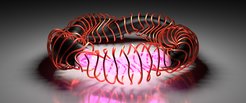Stellarator Reactor Studies
The independent research group Stellarator Reactor Studies (SRS) is concerned with the scientific design of a stellarator-type fusion power plant. The aim is to combine various physical and engineering (as well as economic) aspects in such a way that complex issues relating to the design of a stellarator power plant can be analysed.

Modern, optimised stellarators, such as those being investigated and developed at IPP, have the advantage of being able to operate completely without plasma current. Stellarators are therefore free of undesirable current-driven instabilities and do not rely on a transformer coil to operate in continuous wave mode. The price to be paid for these advantages is the complex shape and structure of the stellarator. This affects not only the plasma physics, but also the technical components such as the magnet system. Handling the complex 3D shapes is a scientific challenge and requires appropriate numerical methods and computer-aided modelling.
The Stellarator Reactor Studies research unit therefore develops, verifies and validates such methods and models - in conjunction with the experiments at Wendelstein 7-X. A particular focus is on engineering aspects that are necessary on the way to a fusion power plant. This concerns not only the superconducting magnetic coils, but also the divertor and the so-called blanket (the inner wall of the plasma vessel).
Another challenge is to bring the various elements together in an overall view. The research unit is developing a special software platform for this purpose: a so-called digital twin - "Stellar-Forge" - which combines physical and technical components as a virtual image of a stellarator fusion power plant. We are trying to achieve a compromise between the accuracy of the results and the computing speed so that, for the first time worldwide, we can map and analyse the complex relationships between the individual subsystems in full three-dimensionality.
Due to the broad spectrum of components and issues to be mapped, the research unit has a multidisciplinary structure. It works closely with other theoretical and experimental research units at the IPP in Garching and Greifswald, as well as with international partners.
